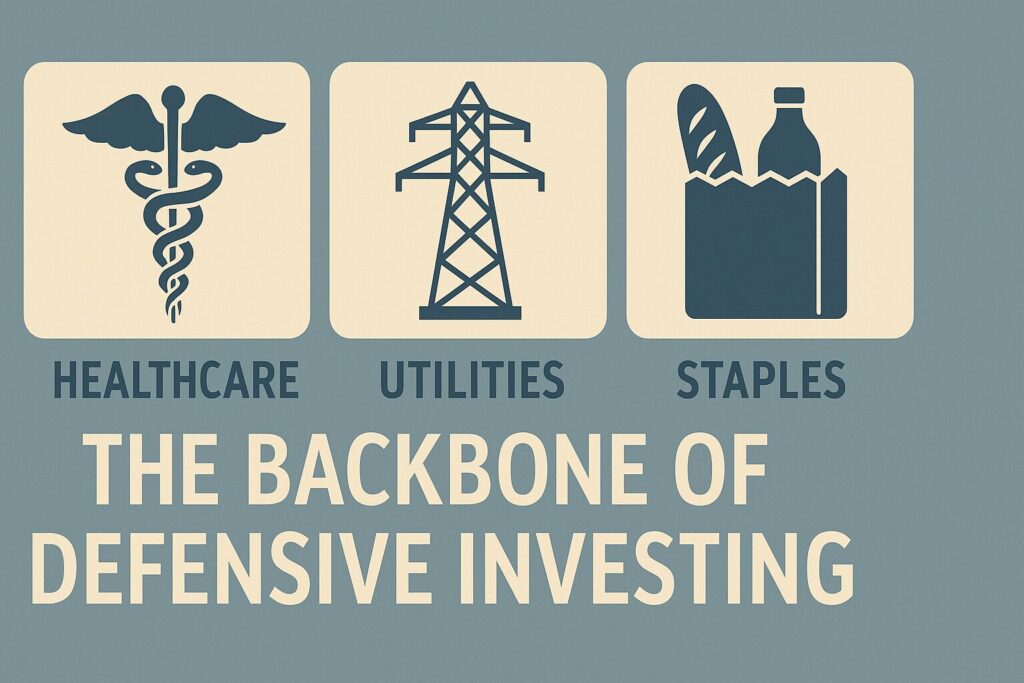
Why These “Boring” Sectors Deliver Steady Returns—Even in Tough Times
When markets get choppy and headlines scream about volatility, many investors start to panic. But some don’t. Instead, they sit back, collect steady dividends, and sleep soundly—because they’ve built their portfolios around defensive sectorslike healthcare, utilities, and consumer staples.
These industries might not be flashy, but they’re essential. No matter what’s happening in the economy, people still need medication, electricity, water, and basic household goods. That’s why these sectors often outperform during downturns and provide reliable income and long-term resilience for retirees and conservative investors alike.
In this post, we’ll explore what makes these three sectors so powerful—and how to invest in them the smart, low-stress way.
🩺 Healthcare: The Ultimate Defensive Growth Sector
Healthcare is one of the few sectors that offers both stability and long-term growth. Thanks to aging populations, rising healthcare spending, and constant innovation, the demand for healthcare products and services rarely slows down.
Why it’s defensive:
- People don’t stop taking medications during recessions.
- Hospitals, insurance companies, and medical device makers continue operating in good and bad times.
- Many healthcare companies pay reliable, growing dividends.
How to invest:
You can invest in a mix of:
- Pharmaceutical giants like Johnson & Johnson or Pfizer
- Medical device makers like Medtronic or Abbott
- Health insurers like UnitedHealth or Humana
- Broad healthcare ETFs like XLV or VHT for instant diversification
Healthcare offers a great combination of growth potential and downside protection—a rare trait in the stock market.
🔌 Utilities: Slow, Steady, and Reliable
Utilities provide the electricity, water, and gas we all depend on. These companies are often regulated monopolies, meaning they operate with stable cash flow and predictable pricing, even in challenging economies.
Why it’s defensive:
- Utility bills still get paid, even when the economy slows.
- Their earnings are not tied to consumer spending or market cycles.
- They often pay high, consistent dividends.
How to invest:
Some of the top utility companies include:
- NextEra Energy (clean energy focus)
- Duke Energy
- American Water Works
Or consider utility ETFs like:
- XLU – Utilities Select Sector SPDR
- VPU – Vanguard Utilities ETF
- UTG – Reaves Utility Income Fund (a closed-end fund with monthly income)
Utilities won’t make you rich overnight, but they can help keep your portfolio grounded and produce steady income, even when the market is in chaos.
🛒 Consumer Staples: Everyday Essentials for Every Economy
Consumer staples companies make the products people buy no matter what—like toothpaste, toilet paper, soap, cereal, and canned goods.
These businesses tend to be less sensitive to economic cycles because their products are everyday essentials.
Why it’s defensive:
- People keep buying groceries, cleaning supplies, and personal care products during recessions.
- Strong brand loyalty gives these companies pricing power.
- Many have decades-long records of paying and increasing dividends.
How to invest:
Well-known consumer staples stocks include:
- Procter & Gamble
- Coca-Cola
- Colgate-Palmolive
- Kimberly-Clark
- Walmart and Costco (defensive retailers)
For diversified exposure, consider:
- XLP – Consumer Staples Select Sector ETF
- VDC – Vanguard Consumer Staples ETF
- FSTA – Fidelity MSCI Consumer Staples ETF
Consumer staples help smooth the ride in your portfolio, offering stability and income when more cyclical sectors falter.
Putting It All Together: A Defensive Foundation
By combining healthcare, utilities, and staples, you create a strong, steady foundation for your portfolio. These sectors don’t always lead the market, but they tend to lose less during downturns and deliver reliable returns over time.
Here’s a sample allocation for a defensive-minded investor:
- 40% Healthcare
- 30% Consumer Staples
- 30% Utilities
You can invest directly in individual stocks, or simply use ETFs to gain diversified exposure with one click.
If you’re a retiree, near-retiree, or someone who just wants less stress and more consistency, this type of portfolio offers a simple and effective solution.
Final Thought: Boring Is Beautiful
In investing, the most exciting stories often come with the most risk. But when it comes to long-term financial security, it’s the boring, essential businesses that often deliver the best results.
Healthcare, utilities, and staples may not grab headlines, but they provide:
- Reliable income
- Resilience in bear markets
- Confidence that your portfolio can weather almost anything
So the next time the market turns turbulent, remember: boring isn’t bad—it’s brilliant.
This post is adapted from my book: Your Boring Portfolio: Get Off the Stock Market Roller-Coaster and Sleep Well at Night With Low-Volatility Stocks, available now at Amazon.com in paperback and eBook formats. Inside, you’ll find easy-to-follow strategies for building a stable, income-producing portfolio using time-tested defensive stocks and ETFs.
Disclaimer: This blog post is for informational and educational purposes only. It is not intended as financial, investment, or tax advice. Always consult a qualified financial advisor before making investment decisions. All investing involves risk, and past performance is no guarantee of future results.